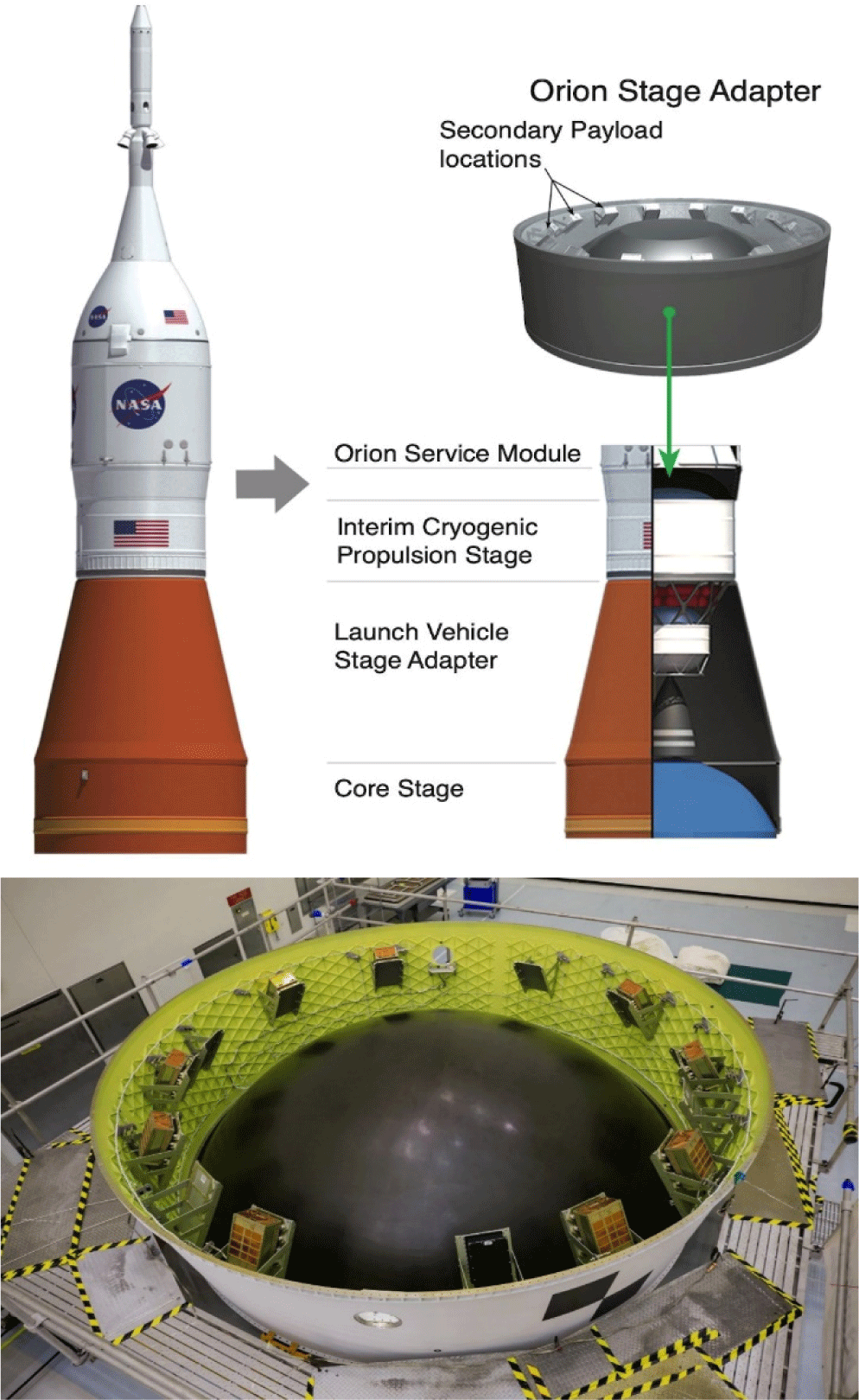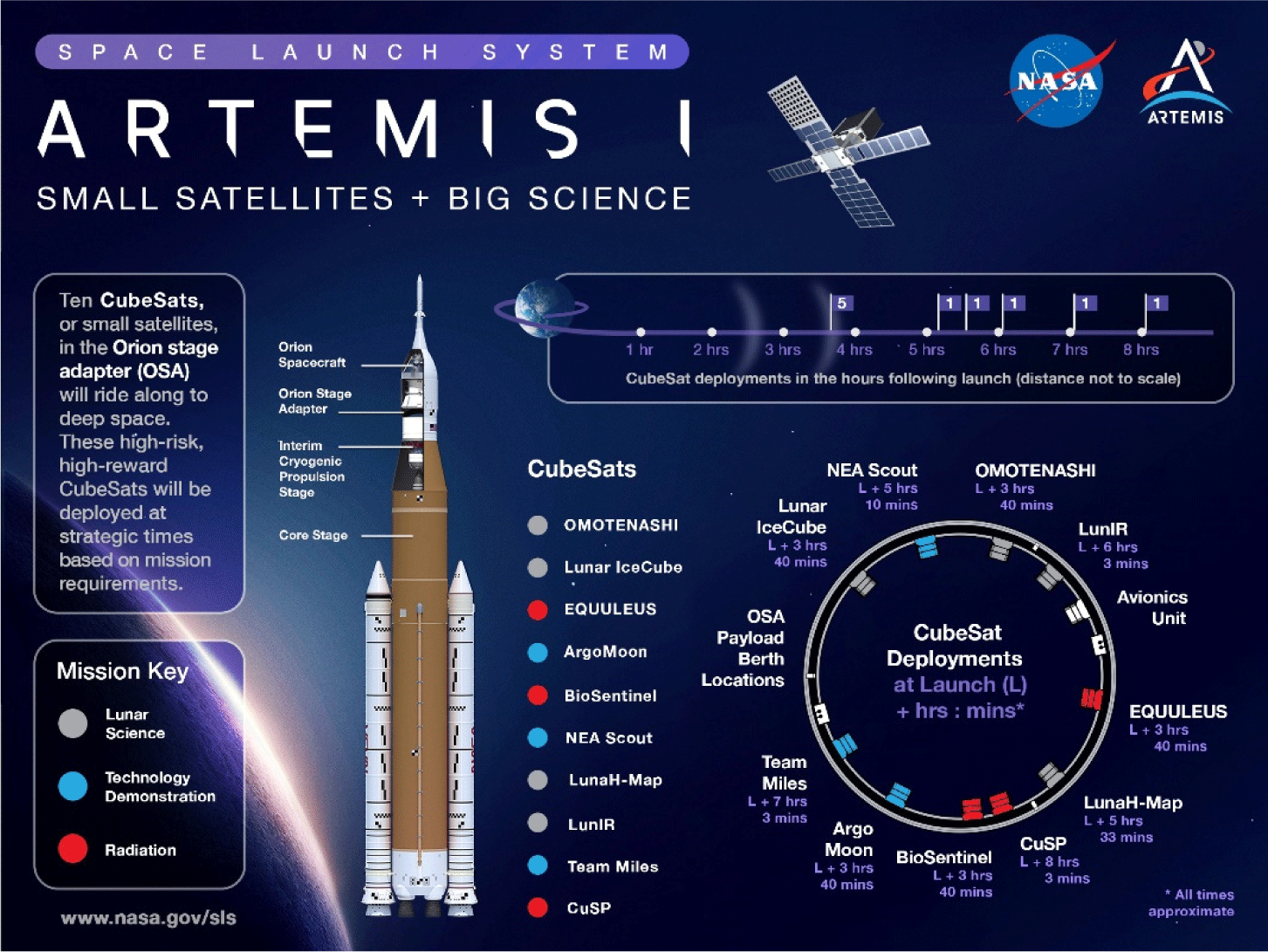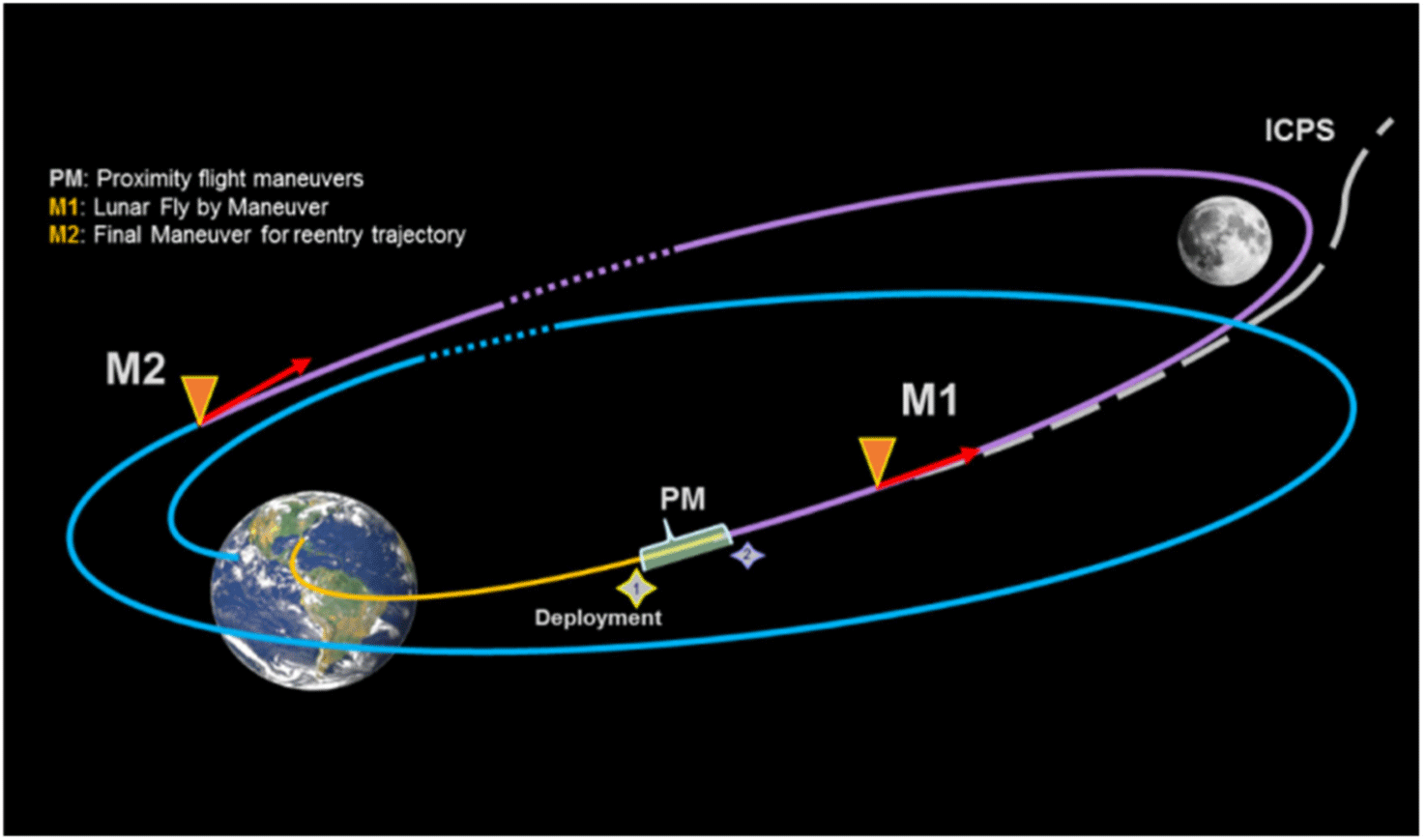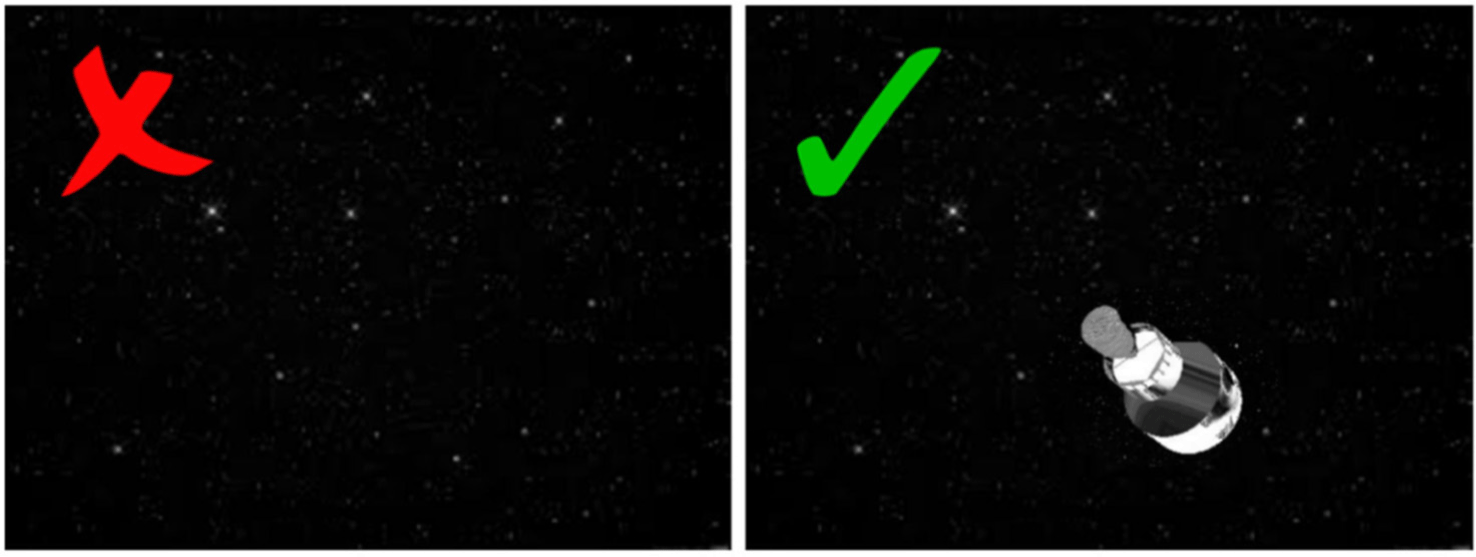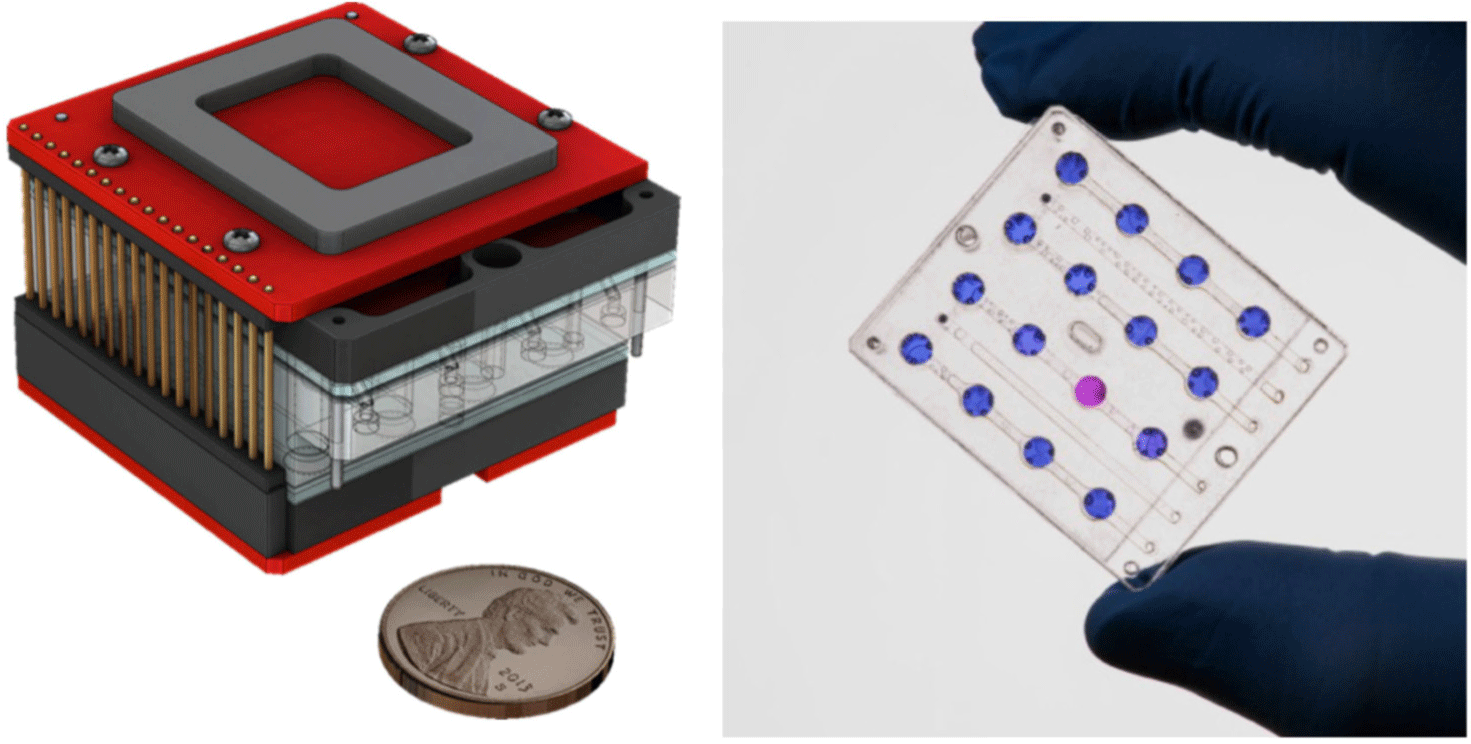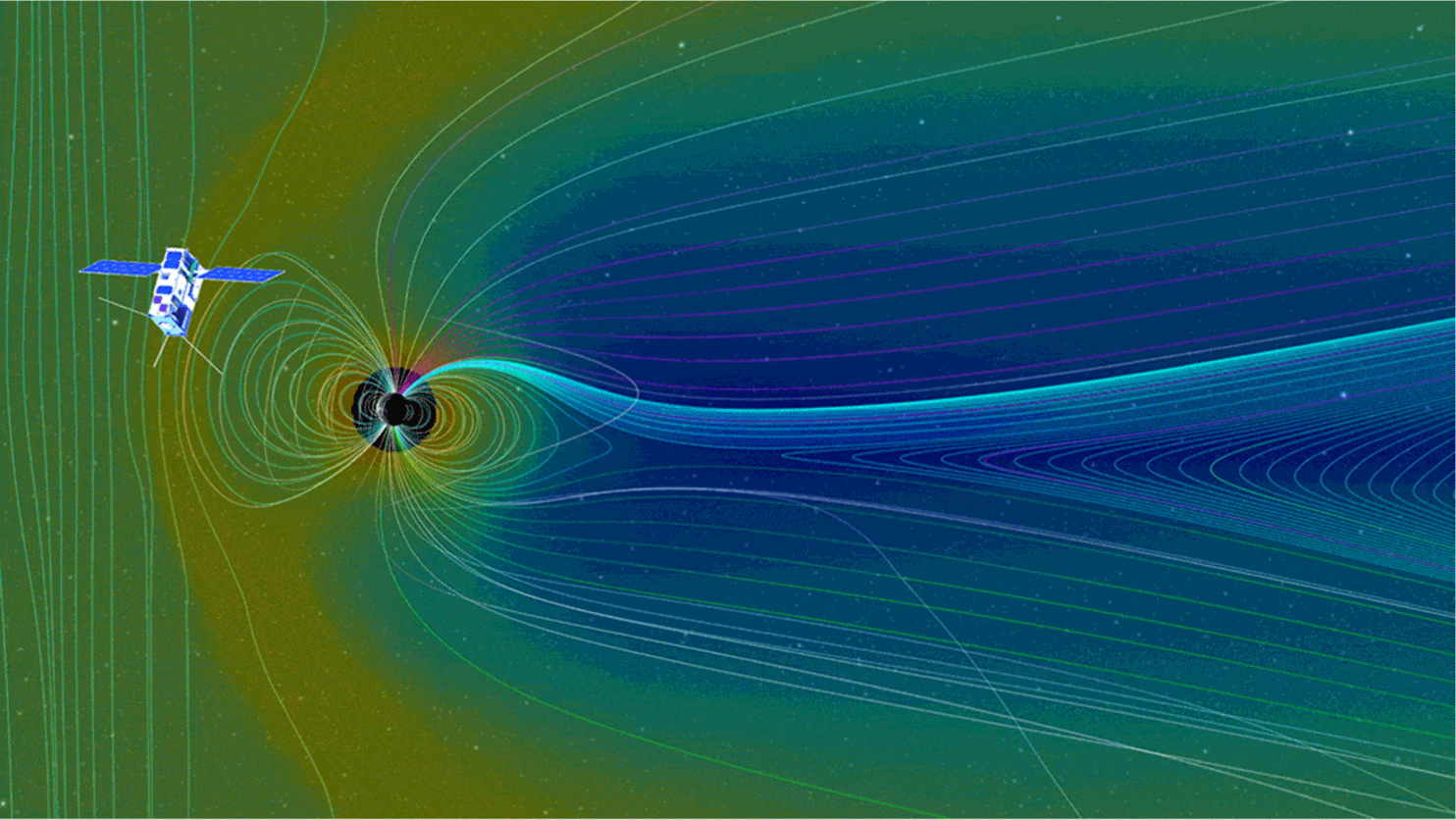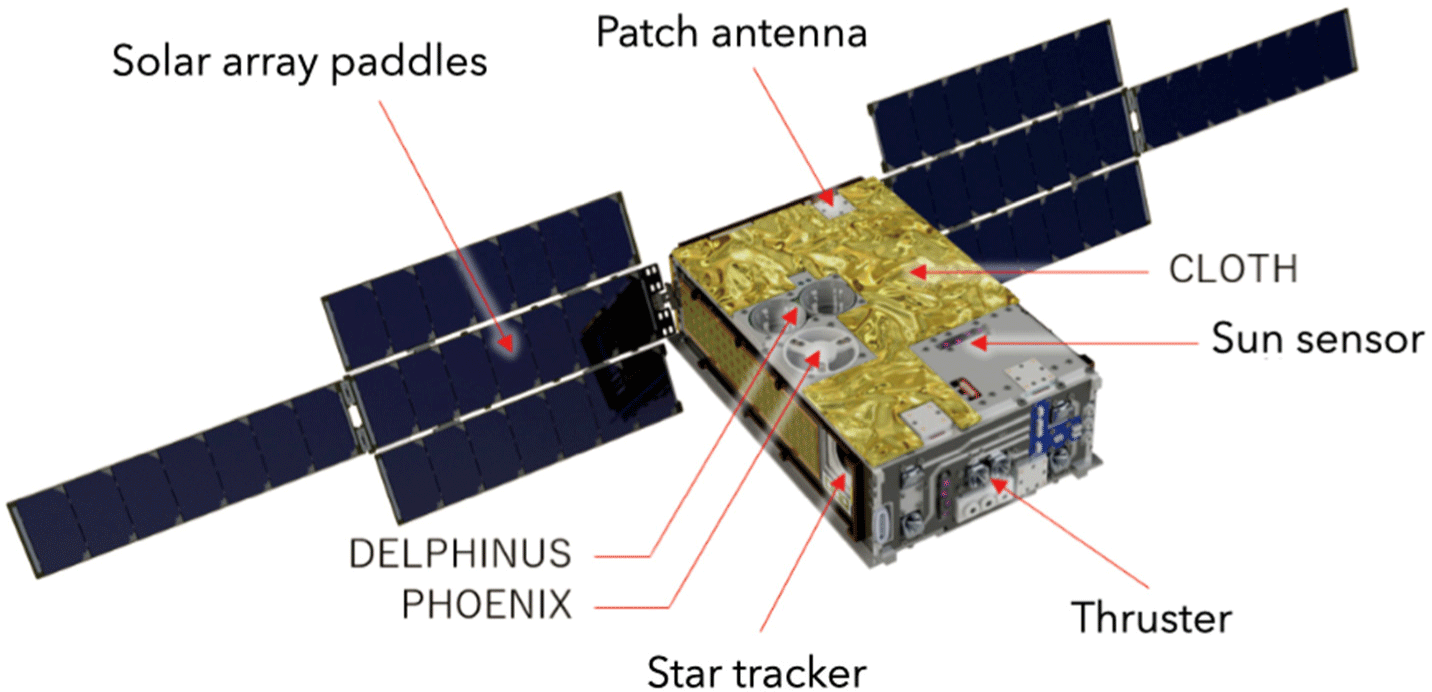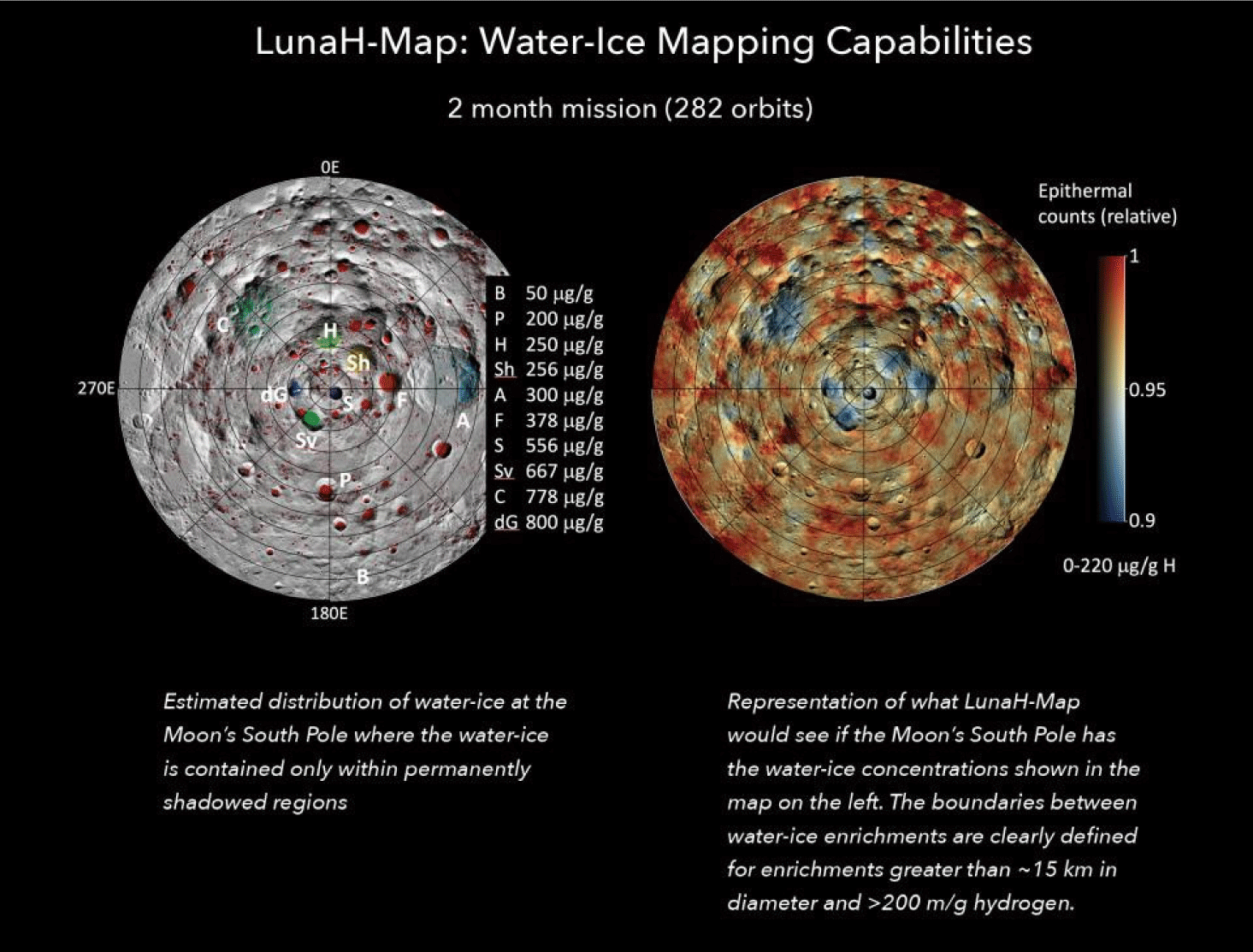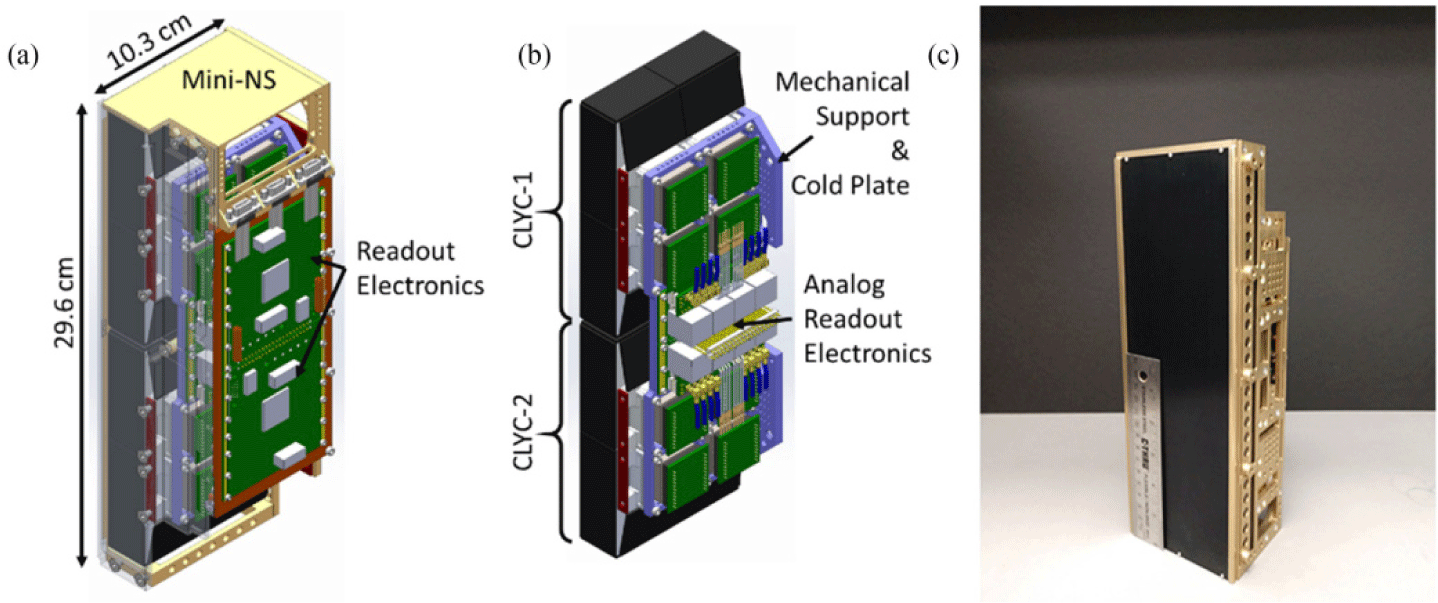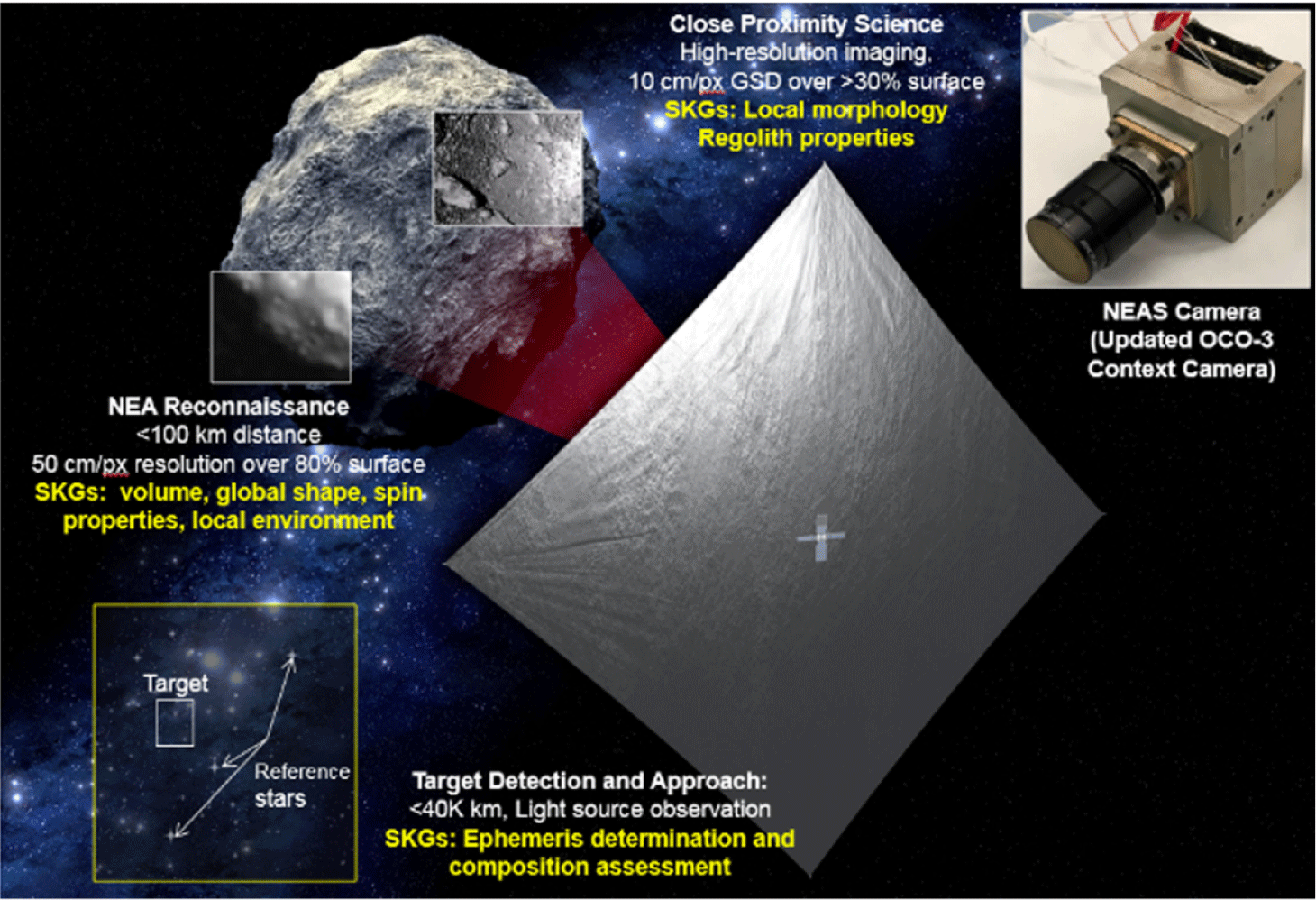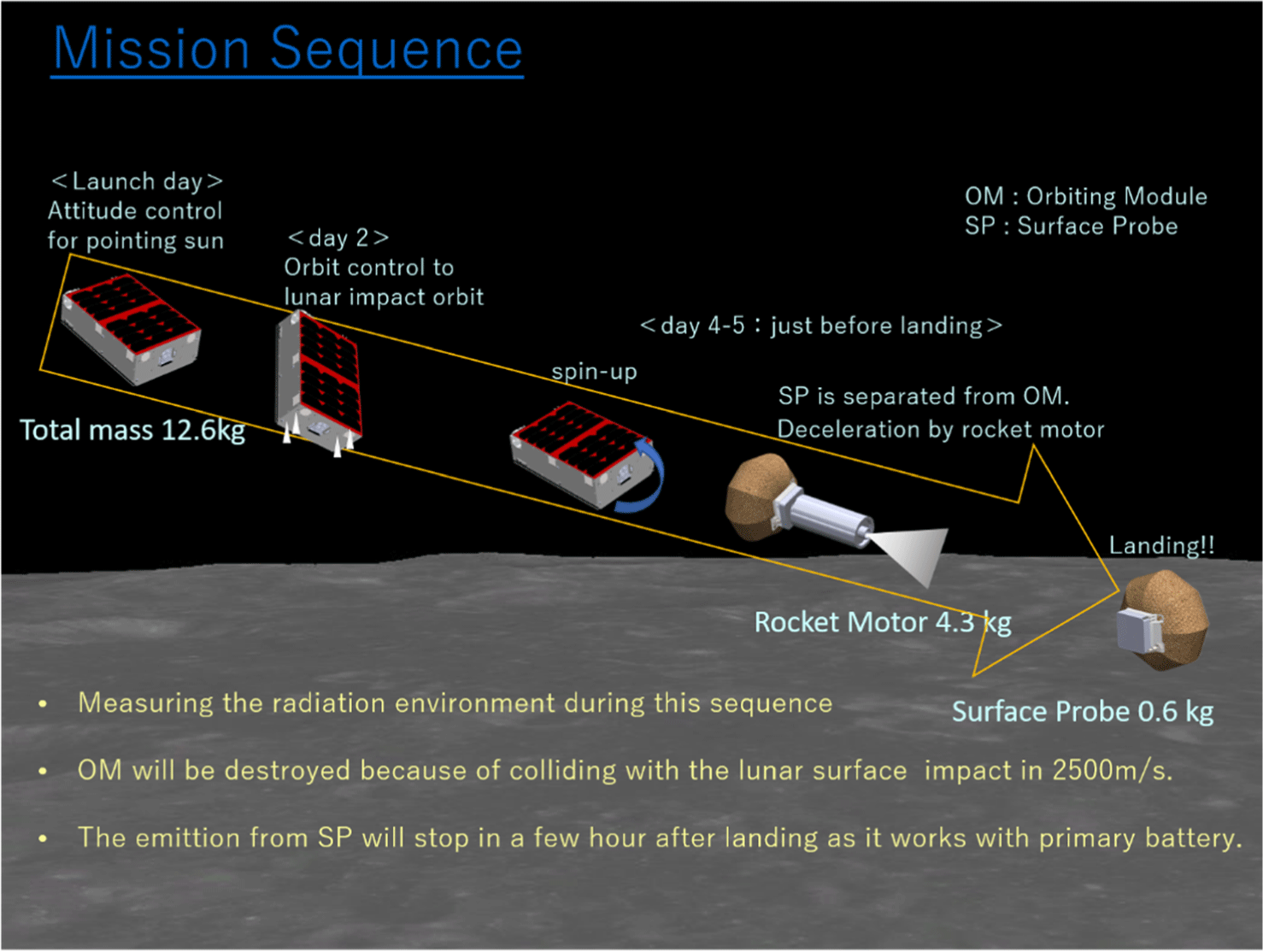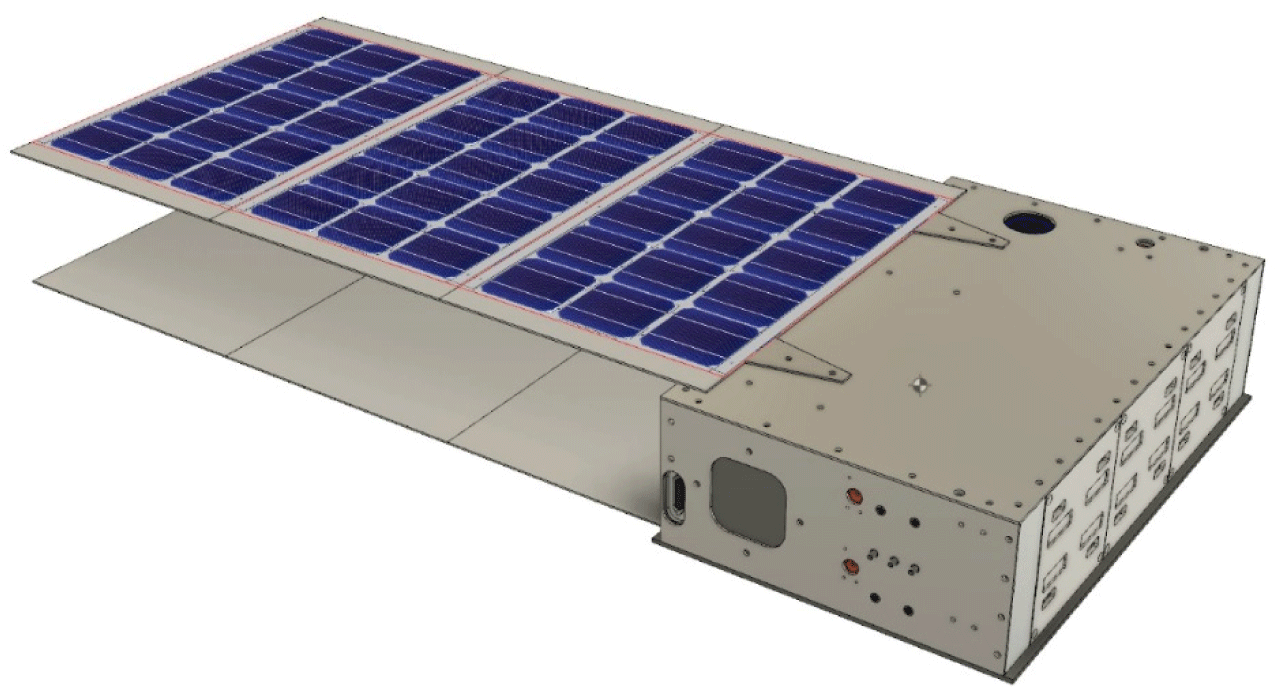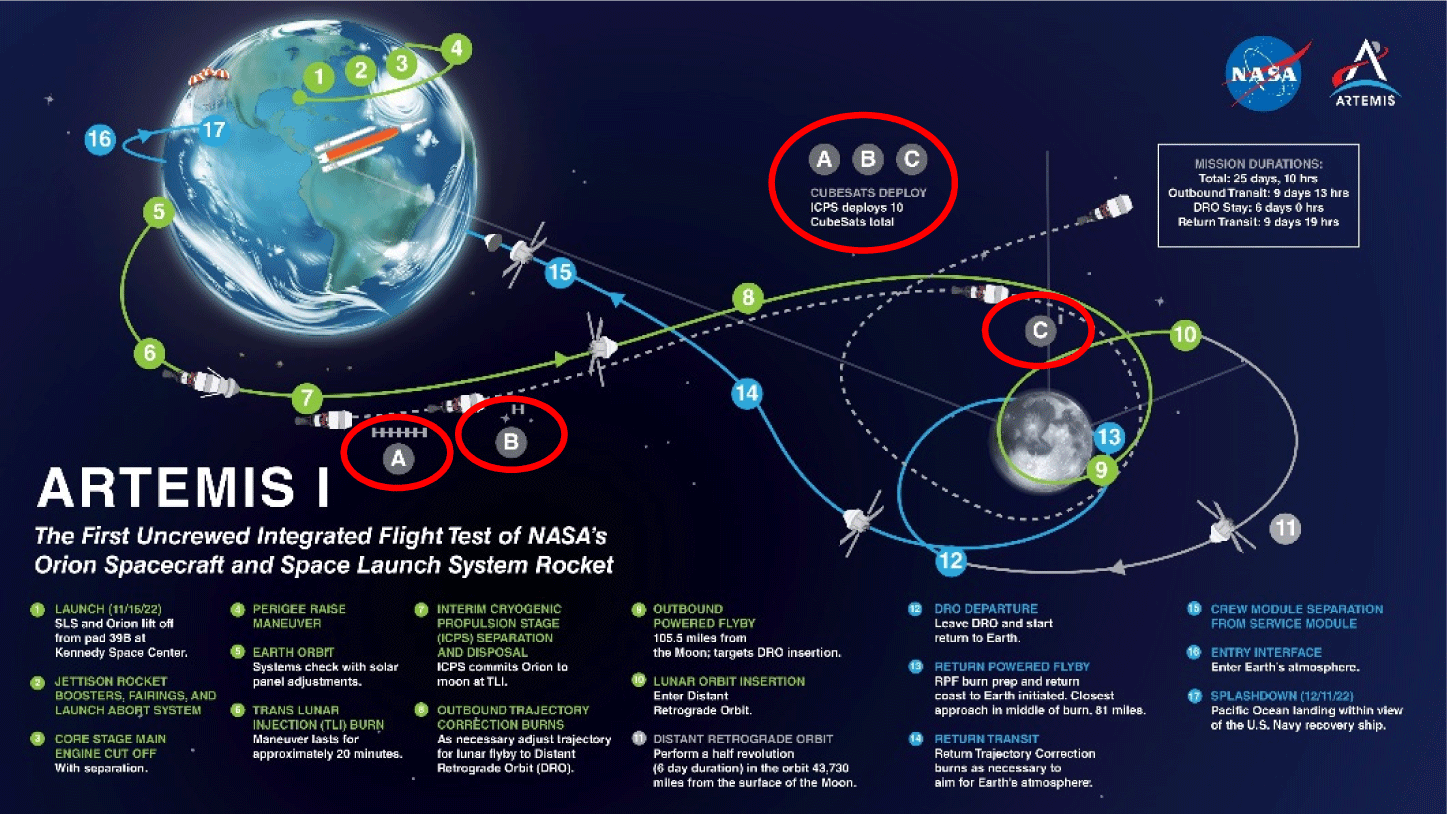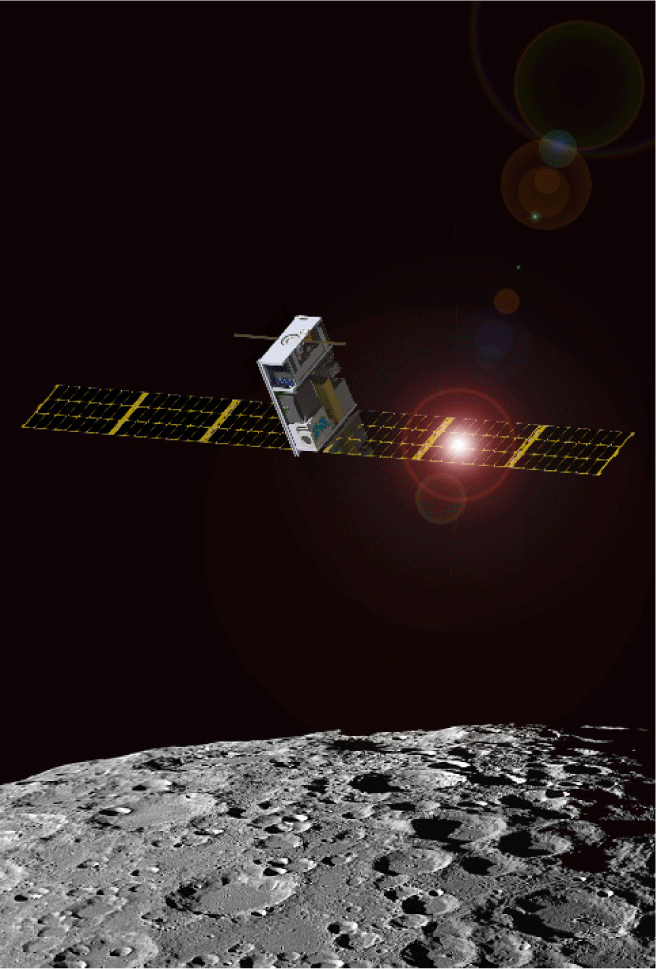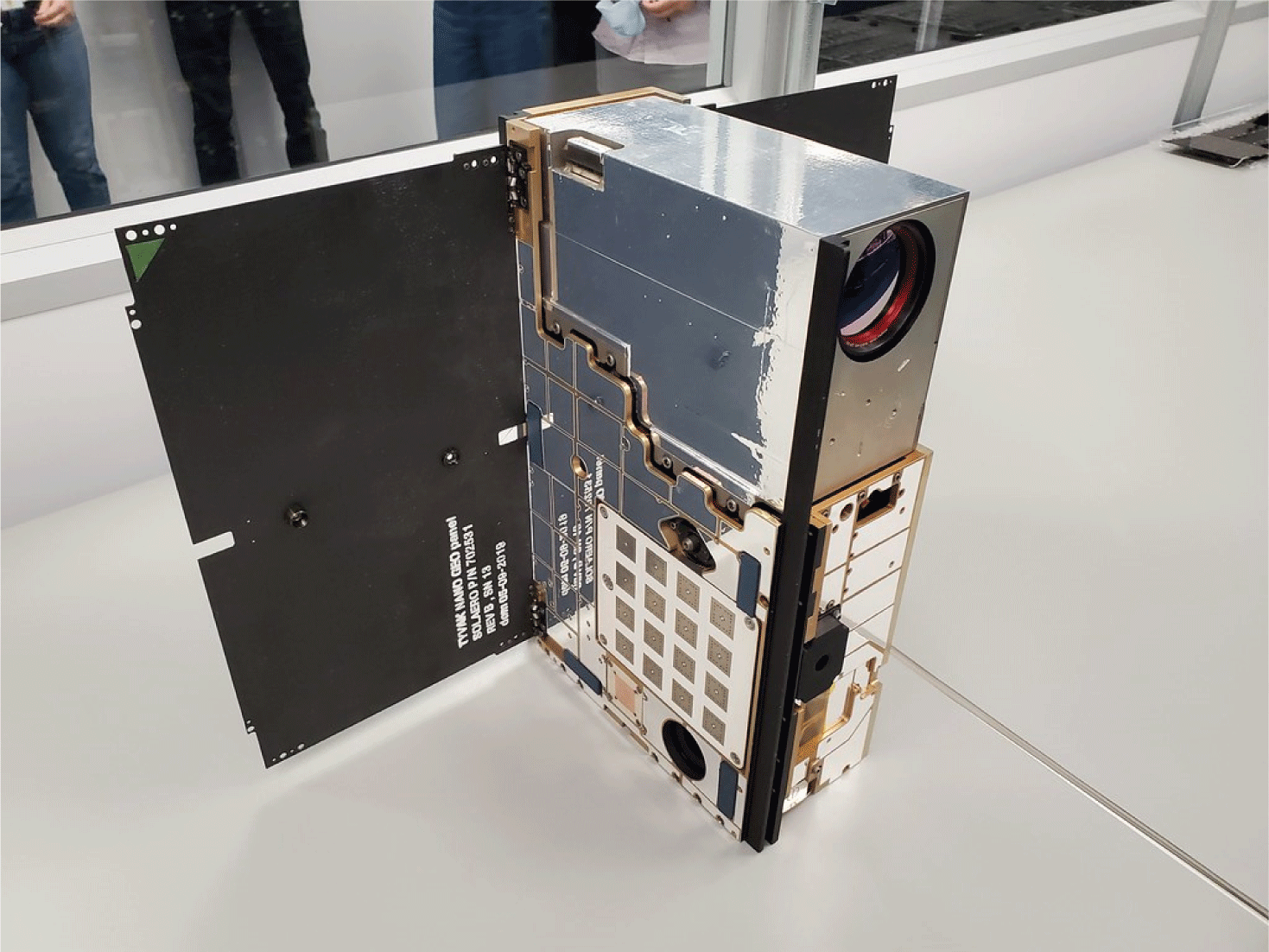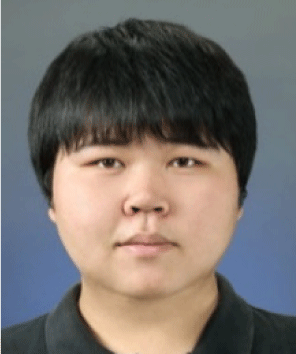기술논문
달탐사 아르테미스 1호에 동반된 초소형위성들 임무 소개 및 기술 동향
김보경
1
, 홍익선
2,†
Introduction of Artemis 1 Nanosatellite Missions and Technology Trends
Bogyeong Kim
1
, Ik-Seon Hong
2,†
1Institute of Natural Sciences, Chungnam National University, Daejeon 34134, Korea
2Department of Astronomy, Space Science and Geology, Chungnam National University, Daejeon 34134, Korea
†Corresponding author : Ik-Seon Hong, Tel : +82-42-821-7492, E-mail :
ishong@cnu.ac.kr
© Copyright 2022 The Korean Space Science Society. This is an Open-Access article distributed under the terms of the
Creative Commons Attribution Non-Commercial License (http://creativecommons.org/licenses/by-nc/4.0/) which permits
unrestricted non-commercial use, distribution, and reproduction in any
medium, provided the original work is properly cited.
Received: Oct 19, 2022; Revised: Nov 02, 2022; Accepted: Nov 08, 2022
Published Online: Nov 30, 2022
요 약
아르테미스 계획(Artemis program)은 미국 NASA에서 추진 중인 유인 달 탐사 계획이다. 아폴로 17호 이후로 전무했던 유인 달 탐사가 재개된다는 점에 큰 의의를 두고 있다. 주 협력국가는 유럽연합(ESA), 일본(JAXA), 캐나다(CSA)가 있으며, 이 계획에 참여하기 위한 국가간 합의인 아르테미스 약정에 우리나라를 포함하여 총 22개 국가가 서명하였다. 아르테미스 계획의 첫 번째 임무인 아르테미스 1호(Artemis 1)는 본격적인 탐사 임무 이전에 발사체와 우주선의 시험을 주 목표로 한다. 부 목표로 아르테미스 1호에 탑재된 10개의 초소형위성들은 사출되어 각자의 임무를 수행한다. 국내에 소개되는 아르테미스 1호는 주 목표 위주로만 내용이 구성되어 있으며, 10개 초소형위성에 대해 다루는 내용이 매우 드물어 각 인공위성들이 어떤 과학적, 기술적 임무를 목표를 가지고 있는지 파악하기 어렵다. 본 논문에서는 국내에 자세히 소개되지 않은 아르테미스 1호의 초소형위성 임무들과 최근 개발 동향을 살펴본다.
Abstract
The Artemis program is a manned lunar exploration plan being pursued by NASA in the United States. It is of great significance that manned lunar exploration has been resumed since Apollo 17. The main partner countries are the European Union (ESA), Japan (JAXA), and Canada (CSA). A total of 22 countries, including Korea, have signed in the Artemis Accords to participate in this program. The first mission of the Artemis program, Artemis 1, is primarily aimed at flight test launch vehicles and spacecraft before full-scale exploration missions. As a secondary mission, 10 nanosatellites mounted on Artemis 1 are deployed and carry out their respective missions. Artemis 1, which is introduced in Korea, consists of only the main mission, and it is very rare to deal with the 10 nanosatellites, making it difficult to understand the scientific and technological mission goals of each nanosatellite. In this paper, the nanosatellite missions of Artemis 1, which have not been introduced in detail in Korea, and the recent trend of nanosatellite development.
Keywords: 아르테미스 계획; 아르테미스 1호; 초소형위성
Keywords: Artemis program; Artemis 1; nanosatellite
1. 서론
아르테미스 계획(Artemis program)은 미국 NASA가 추진하는 유인 달 탐사 계획으로 달 유인기지 건설과 화성 유인 탐사 준비를 목표로 하고 있다. 아폴로 계획(Apollo program) 이후 50여 년간 수행된 적이 없는 대규모 유인 탐사이기에 다른 국가들과 협력하는 형태를 취하고 있다. 주 협력국가는 유럽연합(ESA), 일본(JAXA), 캐나다(CSA)이다. 그 외 아르테미스 계획에 함께하길 원하는 국가들은 아르테미스 약정(Artemis Accords)에 서명을 하는 형태로 참가하고 있다. 우리나라도 2021년 아르테미스 약정에 서명하였다[1]. 현재는 우리나라를 포함하여 총 22개 국가가 참여하고 있다.
아폴로 계획처럼 단순 탐사 임무가 아닌 달에 기지를 건설하여 인류 정착을 목표로 하고 있기 때문에 발사체, 우주선, 우주정거장 등의 임무가 맞물려 진행되어야 한다. 발사체는 SLS(space launch system)를 사용한다. SLS는 현재는 취소된 미국의 컨스텔레이션 계획(Constellation program)에서 사용할 예정이었던 Ares I과 Ares V 발사체와 우주왕복선을 대체하기 위해 만들어졌다[2]. 또한 현존하는 발사체 중 추력이 가장 강하고 탑재체 수용 용량도 가장 크다[3]. 아르테미스 계획에서는 유인 우주선인 Orion을 우주로 보내는 것을 목표로 하고 있다. 현재 계획은 총 5번의 발사가 예정되어 있으며, 각각 아르테미스 1∼5호(Artemis 1∼5)로 명명되어 있다.
아르테미스 1호(Artemis 1)는 SLS를 사용하는 첫 번째 임무로 Orion 우주선의 무인 달 궤도 시범 비행이 목표이다. SLS의 목표는 Orion이 달 궤도로 가기 위한 우주선 추진 기동인 trans-lunar injection을 수행할 수 있도록 지구 궤도에서 사출하는 것이다[4]. 아르테미스 1호는 위의 임무만이 아니라 두 번째 임무도 존재한다. 최근 우주탐사 분야에서 적은 예산으로도 임무를 수행할 수 있는 인공위성 플랫폼으로 초소형위성이 각광받고 있으며, 아르테미스 계획도 그 영향을 받아 10개의 초소형위성을 우주로 보내는 아르테미스 1호의 두 번째 임무가 수립되었다.
Orion의 목표는 달 궤도를 시범 비행하면서 우주비행사들이 받을 수 있는 여러 영향들을 조사하는 것이다. 그래서 각종 계측기들을 장착한 마네킹을 탑재하고 있으며, 주요 계측기는 방사선, 진동, 가속도 등을 측정한다.
국내에서는 아르테미스 계획의 중요성과 화제성을 인식하고 방송, 신문 기사, 과학잡지 칼럼 등 여러 매체를 통해 대중과 관련 업계 종사자, 연구자들에게 소개가 많이 되고 있다. 하지만 아르테미스 1호 임무에 관한 내용들을 확인해보면 대부분 SLS 발사체와 첫 번째 목표인 Orion 우주선의 시범 비행에 대한 소개이고, 두 번째 목표인 초소형위성 임무에 대한 내용의 거의 없다시피 하다. 해외 매체를 확인해보면 초소형위성 임무에 대한 자료가 부족한 것이 아니므로 국내에선 첫 번째 임무에 비해 상대적으로 관심도가 떨어져서 많이 다루지 않은 것으로 판단된다. 따라서 대중과 관련업계 종사자, 연구자들에게 국내에 많이 알려지지 않은 아르테미스 1호의 두 번째 임무인 10개의 초소형위성 임무들을 소개하고, 최근 초소형위성을 이용한 우주 탐사 동향을 파악한다.
2. 초소형위성 임무 개요
SLS에는 6U 규격의 초소형위성 10개가 장착되어 각 위성의 임무를 수행하기 위한 궤도에서 사출 우주로 사출되도록 설계되어 있다[5]. 위성들이 탑재되는 위치는 SLS의 앞부분과 Orion 우주선을 연결하는 OSA(orion stage adaptor) 안쪽이다(Fig. 1). 아르테미스 1호의 임무 시나리오는 Fig. 2에 나타냈으며, 발사 후 달 궤도에 진입하고 다시 지구로 귀환하는 여정으로 총 임무 기간은 25일이다. 임무 시나리오에서 초소형위성이 사출되는 시점은 Fig. 2의 A, B, C 단계로 A 단계에서는 7개, B 단계에서는 2개, 마지막 C 단계에서 나머지 1개의 초소형위성이 사출된다.
Fig. 1.
CubeSats mount locations and appearance in SLS. (top) The front part of the SLS connecting with the Orion spacecraft. CubeSats are mounted inside the Orion stage adaptor. (bottom) Attached CubeSats in the ring-shaped Orion stage adapter (Image Credit: NASA).
Download Original Figure
OSA 내부에 장착된 초소형위성의 배치와 임무 유형은 Fig. 3에 나타냈다. 초소형위성들의 임무는 달 과학, 우주 복사, 기술 시험 세 가지로 분류할 수 있으며, 달 과학 4개, 우주 복사 3개, 기술 시험 3개이다. 초소형위성 10개의 이름과 임무유형, 그리고 임무 목표는 Table 1에 나타냈다. 위성들은 임무 시나리오의 A, B, C 단계에서 동시에 사출되지 않고, 각각의 임무 요구사항에 맞춰 사전에 정해진 일정을 따라 순차적으로 사출되도록 설계되어 있다.
Fig. 3.
Placement and deployment schedule of CubeSats inside the OSA. Each satellite is designed to be deployed sequentially according to mission requirements (Image Credit: NASA). OSA, orion stage adaptor.
Download Original Figure
Table 1.
Mission summary of 10 CubeSats on Artemis 1
|
Name |
Type |
Mission |
|
ArgoMoon |
Technology demonstration |
Detailed photographs of the SLS secondary propulsion stage |
|
BioSentinel |
Radiation |
Research on the effects of deep space radiation on living organisms |
|
CuSP |
Radiation |
Solar particle monitoring in interplanetary space |
|
EQUULEUS |
Radiation |
Observation Earth’s plasmasphere to understand the radiation in the space environment |
|
LunaH-Map |
Lunar science |
Mapping of lunar surface deposits to find out water content |
|
Lunar IceCube |
Lunar science |
Explore water and other resources on lunar surface |
|
LunIR |
Lunar science |
Spectroscopy and thermography of the lunar surface with infrared |
|
NEA Scout |
Technology demonstration |
Flyby the asteroid and observation of the surrounding environment using solar sail |
|
OMOTENASHI |
Lunar science |
Lunar landing and observation of radiation environment of the lunar surface |
|
Team Miles |
Technology demonstration |
Demonstration of deep space navigation with plasma thrusters |
Download Excel Table
3. 초소형위성
3.1 ArgoMoon
ArgoMoon은 Italian Space Agency가 설계한 초소형위성이다. 임무는 두 가지 단계로 구분되어 있으며(Fig. 4), 각각의 임무를 수행하기 위한 카메라와 추진체가 탑재된다(Table 2)[6]. 첫 번째 임무는 Orion이 SLS과 분리된 이후 SLS의 상단부인 Interim Cryogenic Propulsion Stage를 촬영한다(Fig. 5). 이 임무를 통해 근거리에 있는 대상과 동시에 움직이는 상황에서 위성의 자세제어와 지향 정확도를 시험한다. 카메라 탑재체는 두 가지로 광각과 협각 카메라이다(Table 3).
Fig. 4.
ArgoMoon mission scenario. First mission is taking picture of the ICPS in PM step. Secondary mission is maneuver in M1 and M2 step [6]. ICPS, Interim Cryogenic Propulsion Stage.
Download Original Figure
Table 2.
ArgoMoon system specification [6]
|
Subsystem |
Specifications |
|
Structure |
6 U CubeSat, Mass - 14 kg |
|
Payload (PL) |
40° and 2.5° Field of View (FOV) cameras |
|
Rangefinder (RF) |
Laser ranging (up to 5 km), supporting navigation |
|
Electric Power System (EPS) |
80 W (maximum) solar panel arrays (SPAs) with 120 Wh batteries |
|
Propulsion System (PS) |
Monopropellant, four cold gas thrusters |
|
Attitude Determination and Control System (ADCS) |
3-axis stabilization, star tracker, sun sensors, reaction wheel |
|
Communication (COMM) |
Four patch antennas
Receiving (RX): 6.2 dB, 85°
Transmitting (TX): 7 dB, 80°
with 3-dB beam-width |
Download Excel Table
Fig. 5.
ArgoMoon first mission concept. Camera payload will take picture ICPS [6]. ICPS, Interim Cryogenic Propulsion Stage.
Download Original Figure
Table 3.
ArgoMoon camera payload specification [6]
|
Name |
Specification |
|
Primary optic |
|
Focal length |
393 mm |
|
FOV |
±2.05° |
|
Image diagonal |
28.2 mm |
|
Wavelength range |
450–700 nm |
|
F/N |
5.2 |
|
Secondary optic |
|
Focal length |
22.42 mm |
|
FOV |
±32.5° |
|
Image diagonal |
28 mm |
|
Wavelength range |
450–700 nm |
|
F/N |
4 |
Download Excel Table
두 번째 임무는 달 근접 통과 시에 위성이 추진 기동하여 달을 fly-by하고 지구 궤도로 이동하는 것이다. 이때 지구궤도는 이심률이 매우 커서 위성이 지구 자기장 밖의 심우주 환경에 놓이게 된다. 지구를 공전하는 인공위성들은 일반적으로 지구 자기장을 활용한 자세제어를 수행하는 데 심우주 환경은 지구 자기장 영향권 밖이므로 다른 방법을 사용해야 한다. ArgoMoon은 추진체를 활용한 기동을 수행하며 심우주에서의 자세제어 기술을 시험한다. 추진체는 1개 단일 추진체와 4개의 cold gas 추진체가 사용된다[7,8].
3.2 BioSentinel
BioSentinel은 생물학 임무를 수행하기 위한 위성이다 임무 목표는 지구 자기장 밖의 심우주 환경에서 방사선이 유기체에 미치는 영향의 조사이다[9]. 유인 우주탐사를 염두에 두는 임무여서 발아 효모를 실험 유기체로 선택하여 임무를 수행한다(Fig. 6). 발아 효모는 DNA가 손상되면 인간의 세포와 유사한 과정을 거쳐 복원하는 특성을 가지고 있다. 또한 심우주에서 수행하는 최초의 생물학 실험이다. 효모는 두 종류인데, 하나는 자연에서 흔히 접할 수 있는 종류이고, 다른 하나는 DNA 복구능력에 결함을 가지고 있는 변종이다. 두 효모가 심우주 환경에서 방사선에 어떻게 반응하는지 비교하면서, 장기간 우주탐사를 수행할 때 인간에게 미칠 위험에 대한 정보를 취득한다. 이 임무를 통해 심우주 환경에서 인간이 받을 수 있는 방사선 피해를 정량화 하고 줄이는 데 도움이 될 것으로 기대된다.
Fig. 6.
Biosensor of BioSentinel. (left) Assembled microfluidic minicard with integral thermal control and optical measurement components. (right) fluidic minicard. A microwell dye that has turned pink due to yeast metabolic activity [9].
Download Original Figure
또한, 국제 우주 정거장(International Space Station, ISS)에서 같은 실험이 수행될 예정이다. ISS는 저궤도(low earth orbit)이므로 심우주와 달리 방사선이 비교적 적고 지구 중력의 영향을 받고 있다. 게다가 중력 및 방사선 조건에 따른 유기체가 받는 영향을 비교하기 위해 지상에서도 같은 실험이 진행될 예정이다.
3.3 CuSP
CuSP(CubeSat for Solar Particles)는 행성 간 공간에서 태양 중심 궤도를 돌며 태양풍이나 플레어(flare), 코로나 질량 방출(coronal mass ejection)과 같은 태양활동에서 기인하는 입자들을 관측하는 우주기상임무 위성이다(Fig. 7)[10]. 지구 자기권 밖에서 태양활동을 감시하는 것은 일반적인 인공위성 운영을 고려했을 때, 시간과 예산의 소모가 매우 크다. 그런 관점에서 비용이 낮고 소규모 위성 플랫폼인 초소형위성이 임무에 적합하다. 계측기는 SIS(suprather-mal ion spectrograph), MERiT(miniaturized electron and proton telescope), VHM(vector helium magnetometer )로 총 3개가 탑재되어 있다(Table 4)[11]. SIS는 저에너지(3∼70 keV ions)의 태양풍 입자 검출, MERiT는 고에너지(2∼170 GeV ions, 100 keV∼4 MeV electron) 태양풍 입자 검출 그리고 VHM은 자기장 강도와 방향을 측정한다.
Fig. 7.
Mission concept of CuSP. It monitors solar activity that affects the Earth outside the Earth's magnetosphere [10]. CuSP, CubeSat for Solar Particles.
Download Original Figure
Table 4.
CuSP system specification [11]
|
Subsystem |
Specification |
|
Structure |
Mass – 14 kg |
|
10 cm × 20 cm × 30 cm (6 unit) |
|
EPS |
SwRI PPT 28 V Main Bus |
|
SwRI LVPS +12 V, +/–5 V, +3.3 V |
|
Clyde Space solar arrays |
|
Clyde Space 60 Whr 8s2p |
|
PL |
SwRi, SIS |
|
NASA GSFC, MERiT |
|
NASA JPL, VHM |
|
PS |
Cold gas thrusters |
|
ADCS |
3-axis stabilization, Sun sensor, Star tracker |
|
COMM |
JPL IRIS 2.0 X-band Transponder |
|
2 JPL Low Gain Patch Array Antenna |
|
1 JPL Medium Gain Patch Array Antenna |
Download Excel Table
3.4 EQUULEUS
EQUULEUS(EQUilibriUm Lunar-Earth point 6U Spacecraft)는 근지구 우주환경을 이해하기 위해 지구 플라스마권을 탐사하는 우주환경 임무 위성이다(Fig. 8). 세부적인 임무는 총 네 가지로 1개의 기술시험 임무, 3개의 과학임무가 있다. 기술시험 임무는 위성이 EML2 (Earth-Moon L2 point)로 가는 동안 여러 번의 달 fly-by와 같은 상황에서의 저추력 궤도 제어 기술을 시험한다. 과학임무 세 가지는 지구 플라스마권의 영상관측, 달 충돌 섬광(impact flash) 관측, 지구-달 영역의 티끌 환경 측정으로 각각의 탑재체가 존재한다[12,13].
Fig. 8.
EQUULEUS design. 3 science payloads will be attached bus system (Image Credit: JAXA). EQUULEUS, EQUilibriUm Lunar-Earth point 6U Spacecraft.
Download Original Figure
PHOENIX(Plasmaspheric Helium ion Observation by Enhanced New Imager in eXtreme ultraviolet)는 극자외선을 촬영하기 위한 카메라로 광학계는 플라스마권의 구성요소인 헬륨 이온의 방출선 파장(30.4 nm)에 최적화 되어 있다. 지구에서 멀리 떨어져 플라스마권의 전체 모습에 대한 영상을 촬영하여 공간적, 시간적 진화에 대한 단서를 찾아낸다.
DELPHINUS(DEtection camera for Lunar impact PHenomena IN 6U Spacecraft)는 달 충돌 섬광을 관측을 목표로 한다. 수 억∼수십 억년 전의 빈도는 아니지만 현재까지도 달에는 운석이 충돌하고 있다. 다만 우리가 일반적으로 보는 밝은 달의 모습에서는 충돌로 인해 발생하는 빛을 식별하기가 어렵다. 반면에 태양빛이 도달하지 않는 음영지역에서의 운석 충돌은 찰나의 섬광을 관측하는 것으로 식별할 수 있다. 위성은 지구에서 관측할 수 없는 시점으로 달을 볼 수 있기 때문에 충돌 섬광 관측에 적합하다.
CLOTH(Cis-Lunar Object Detector within Thermal Insulation)는 위성 외부에 장착된 티끌 계측기로 유성체 충돌을 감지하여, 지구-달 사이 공간의 티끌의 크기와 공간 분포를 알아내는 것이 목표이다. 최초로 EML2 지역의 티끌 환경을 측정하는 임무로 미래 우주비행사가 EML2를 지날 때 티끌의 위험도를 예측하는 용도로 활용할 수 있다.
3.5 LunaH-Map
LunaH-map(Lunar Polar Hydrogen Mapper)은 달 남극 영구 음영 지역(permanently shadowed regions, PSRs)의 수소 함량 지도를 제작하는 임무를 가지고 있다(Fig. 9). 기존의 Lunar Prospector와 LRO(Lunar Reconnaissance Orbiter)의 관측보다 향상된 공간해상도로 고품질의 수소 지도를 제작한다[14]. 이번 임무를 통해 이전 임무에서 잠정적으로 확인된 얼음의 깊이와 주변 축적물의 분포를 자세히 확인함으로써 앞으로 사용할 예정인 물의 양을 파악하는 데 도움이 될 수 있다. 위성은 달 궤도를 돌다가 연료를 소진한 후 달의 남극 지역에 충돌하여 임무를 종료할 예정이다.
Mini-NS(miniature neutron spectrometer)는 중성자 분광기로 LunarH-Map의 탑재체이다(Fig. 10). 우주선(cosmic ray)이 달과 충돌하여 표면 아래까지 전달된 에너지로 인해 중성자가 발생한다. 그중 열외 중성자(epithermal neutron > 0.3 eV)는 수소와 충돌하였을 때, 에너지를 잃어 달 표면에 포집되며 에너지를 방출하게 된다. Mini-NS는 위의 과정으로 표면에서 방출되는 열외 중성자 에너지를 측정함으로써 수소의 존재를 감지하도록 설계되었다(Table 5).
Fig. 10.
Mini-NS structure and appearance. (a) Mechanical structure of the Mini-NS. (b) Eight detector modules are attached inner structure. (c) Assembled Mini-NS [14]. Mini-NS, miniature neutron spectrometer.
Download Original Figure
Table 5.
Specifications of the Mini-NS instrument [14]
|
Name |
Specifications |
|
Detector (2 per instrument) |
2 × 2 Array of 4 × 6.3 × 2.0 cm CLYC Crystal Modules |
|
Sensitivities |
Epithermal (E > 0.3 eV) neutrons |
|
Dimensions |
25 × 10 × 8 cm |
|
Mass |
3.4 kg |
|
Power |
3.6 W (standby), 9.6 W (data acquisition) |
|
Data acquisition times |
Counts binned every 1 second |
|
Data rate |
14 Byte/s (50 kB/s stored locally) |
Download Excel Table
3.6 Lunar IceCube
Lunar IceCube는 달의 물을 비롯한 휘발성 물질[organic volatile(H2S, NH3, CO2, CH4, OH)]을 관측하는 임무를 수행한다(Fig. 11). 이전의 탐사로부터 달의 고위도 지역에 물과 수산기(hydroxyl)가 존재하는 것을 확인했으나, 기존 계측기들의 설계는 물 관측을 염두에 두지 않아 완벽한 관측에 한계가 있었다. 그래서 달의 물과 휘발성 물질 특성에 맞춘 계측기 BIRCHES(Broadband Infrared Compact High-Resolution Exploration Spectrometer)를 설계하여 탑재한다[15].
BIRCHES는 명왕성을 탐사했던 New Horizons의 적외선 분광기 Ralph 탑재체를 소형화 한 것으로 초소형위성 탑재를 목표로 개발한 초경량의 분광기이다. 크기를 줄이기 위해 회절격자(grating)과 같은 고전적인 형태의 광학계가 아닌 linear variable filter를 사용하였으며 관측 파장은 1∼4.3 μm로 물의 분광 특성이 나타나는 3 μm 영역을 포함하며, 분광해상도는 5 nm로 매우 높다[16].
3.7 LunIR
본래 이름은 SkyFire로 알려졌던 초소형위성으로 달과 화성을 분광관측, 열화상 관측을 목표로 하고 있었으나 아르테미스 1에 참가하면서 LunIR로 이름을 바꾸고 대상을 달로 제한하였다(Fig. 12)[17]. 위성의 탑재체는 1개의 적외선 센서로 달의 낮과 밤 상관없이 중적외선(mid-wave IR) 대역에서 달 표면의 스펙트럼과 열화상을 한꺼번에 촬영할 수 있는 특징이 있다[18]. 중적외선에서의 관측 특성으로 인해 센서를 열에 의한 영향에 취약해 관측 자료에 품질을 저하시킬 수 있다. 그래서 센서를 냉각시킬 소형 냉동기(micro-cryocooler) 제작하여 기존의 냉동기들 보다 무게가 가볍고 수명이 길다는 장점이 있다.
3.8 NEA Scout
NEA(near-earth asteroid) Scout는 태양 돛(solar sail)을 사용한 소행성 탐사를 임무로 하고 있다(Fig. 13). 위성에서 일반적으로 사용하는 물질을 분사하는 추력체를 사용하는 것이 아닌 태양의 복사압(radiation pressure)으로 추력을 받으므로 추력 자체의 강도는 낮으나, 위성의 무게감소, 예산 절감 등의 효과가 있어 태양 돛은 초소형위성에서 적합한 사양이다.
SLS에서 사출된 이후에는 지구로부터 1 AU 안쪽에 있는 크기 100 m 미만의 NEA에 접근하여 영상을 촬영하고 소행성의 회전 특성, 표면 특성을 규명한다[19]. 관측할 수 있는 소행성은 2020∼2024년 기간을 기준으로 약 40여 개가 있다. 카메라는 Mars 2020 로버의 내비게이션 카메라(navigation camera)와 유사하다[20].
3.9 OMOTENASHI
OMOTENASHI(Outstanding MOon exploration TEchnologies demonstrated by NAno Semi-Hard Impactor)는 달 표면에 경착륙(hard landing)하여 달 표면의 방사선 환경을 측정하는 임무를 가지고 있다[21]. 위성은 착륙을 위해 궤도 모듈(orbital module, OM), 로켓 모듈(rocket module, RM), 표면 모듈(surface module, SP) 세 가지로 구성된다[22].
착륙 시나리오는 위성(OM)에서 착륙시 충격흡수 역할을 하는 에어백을 펼친 후 착륙선(SP)이 사출되고, SP와 결합되어 있는 역추진 모터(RM)를 사용하여 자유낙하 수준의 속도로 줄인 다음에 SP와 RM이 분리하여 SP는 달 표면에 경착륙 한다(Fig. 14).
Fig. 14.
OMOTENASHI mission scenario (Image Credit: JAXA). OMOTENASHI, Outstanding MOon exploration TEchnologies demonstrated by NAno Semi-Hard Impactor.
Download Original Figure
3.10 Team Miles
Team Miles는 플라스마 추력기를 사용한 우주 항법 시연을 임무로 하고 있다. 위성에는 총 12개의 추력기를 사용하여 궤도 이동과 같은 기본적인 추진과 자세 제어에 모두 사용된다 (Fig. 15)[23]. 위성은 추력기를 사용해서 달 너머 400만 km의 장거리 비행을 목표로 한다. 하지만 초소형위성 임무들이 주로 사용하는 소규모의 지상국으로는 장거리 통신의 어려움이 있다. 그래서 NASA의 deep space network를 통해 위성과 통신을 한다.
Fig. 15.
Team Miles satellite structure. 12 thrusters are attached to right side in this image (Image credit: Team Miles).
Download Original Figure
4. 결론
아르테미스 1의 초소형위성의 임무는 총 10개로 각자 다양한 과학적, 기술적 목표를 가지고 있다. 이러한 임무 선정은 Orion이 달 궤도로 가는 여정에서 최대한의 효율을 고려했을 때 합리적이다. 일반적인 인공위성과는 달리 소규모로 진행되는 초소형위성의 제작 특성상 위성 및 탑재체의 상세한 사양의 공개 여부에서 각 위성들마다 편차가 존재한다.
임무의 관점에서 과학적 목표는 우주환경과학과 행성과학 두 가지로 구분된다. 우주환경은 태양활동과 지구 자기권, 플라스마권의 상호작용을 주제로 하고 있으며, 행성과학은 주로 달 표면의 물을 탐색하기 위한 분광관측을 주제로 하고 있다. 기술적 목표는 위성체를 추력기를 사용한 우주 항법 시연이다.
초소형위성이 처음 도입된 이후, 대부분 임무들은 지구궤도상에서 이루어졌으나, 이번 아르테미스 1호로 인해 지구궤도 밖에서의 임무가 진행된다. 다만 초소형위성의 임무 성공 사례가 제작 및 발사되는 빈도에 비해 매우 적어서 우려되는 부분이 있으나, 위성의 임무 성공으로부터 과학적인 결과를 도출하기 이전에 새로운 임무의 설계 및 구현이라는 관점에서 보면 이번 아르테미스 1호 초소형위성 임무는 큰 발전이라고 볼 수 있다.
감사의 글
이 연구는 정부(과학기술정보통신부)의 재원으로 한국연구재단의 지원을 받아 수행되었습니다(NRF-2022R1A2C1092602).
References
United States Congress, S.3729 - National Aeronautics and Space Administration Autho-rization Act of 2010, 111th Congress (2009–2010).

Tana VD, Cotugno B, Simonetti S, Mascetti G, Scorzafava E, et al., ArgoMoon: there is a nano-eyewitness on the SLS, IEEE Aerosp. Electron. Syst. Mag. 34, 30-36 (2019).


Ricco AJ, Santa Maria SR, Hanel RP, Bhattacharya S, BioSentinel: a 6U nanosatellite for deep-space biological science, IEEE Aerosp. Electron. Syst. Mag. 35, 6-18 (2020).


George DE, The CuSP interplanetary CubeSat mission, Proceedings of the 13th Annual CubeSat Developers Workshop, San Luis Obispo, CA, 20-22 Apr 2016.

Ikari S, Ozaki N, Nakajima S, Oguri K, Miyoshi K, et al., EQUULEUS: mission to earth - moon lagrange point by a 6u deep space cubesat, Proceedings of the 31st Annual Conference on Small Satellite, Logan, UT, 5-10 Aug 2017.

Ikari S, Fujiwara M, Kondo H, Matsushita S, Yoshikawa I, et al., Solar system exploration sciences by EQUULEUS on SLS EM-1 and science instruments development status, Proceedings of the 33rd Annual Conference on Small Satellite, Logan, UT, 3-8 Aug 2019.

Hardgrove C, Starr R, Lazbin I, Babuscia A, Roebuck B, et al., The lunar polar hydrogen mapper cubesat mission, IEEE Aerosp. Electron. Syst. Mag. 35, 54-69 (2020).


Malphrus BK, Brown KZ, Garcia J, Conner C, Kruth J, et al., The lunar IceCube EM-1 mission: prospecting the moon for water ice, IEEE Aerosp. Electron. Syst. Mag. 34, 6-14 (2019).


Clark PE, Malphrus B, Brown K, Fite N, Schabert J, et al., Preparing for delivery of the Lunar IceCube compact IR spectrometer payload, Proceedings of the CubeSats and SmallSats for Remote Sensing IV, online conference, 24 Aug-4 Sep 2020.


Lockett TR, Castillo-Rogez J, Johnson L, Matus J, Lightholder J, et al., Near-Earth asteroid scout flight mission, IEEE Aerosp. Electron. Syst. Mag. 35, 20-29 (2020).


Lightholder J, Thompson DR, Castillo-Rogez J, Basset C, Near Earth asteroid scout cubesat science data retrieval optimization using onboard data analysis, Proceedings of the 2019 IEEE Aerospace Conference, Big Sky, MT, 2-9 Mar 2019.


Campagnola S, Hernando-Ayuso J, Kakihara K, Kawabata Y, Chikazawa T, et al., Mission analysis for the EM-1 cubesats EQUULEUS and OMOTENASHI, IEEE Aerosp. Electron. Syst. Mag. 34, 38-44 (2019).


Hashimoto T, Yamada T, Otsuki M, Yoshimitsu T, Tomiki A, et al., Nano semihard moon lander: OMOTENASHI, IEEE Aerosp. Electron. Syst. Mag. 34, 20-30 (2019).


Hyde L, Cockrell J, NASA's cube quest challenge - from ground tournaments to lunar and deep space derby, Proceedings of the AIAA SPACE and Astronautics Forum and Exposition, Orlando, FL, 12-14 Sep 2017.


